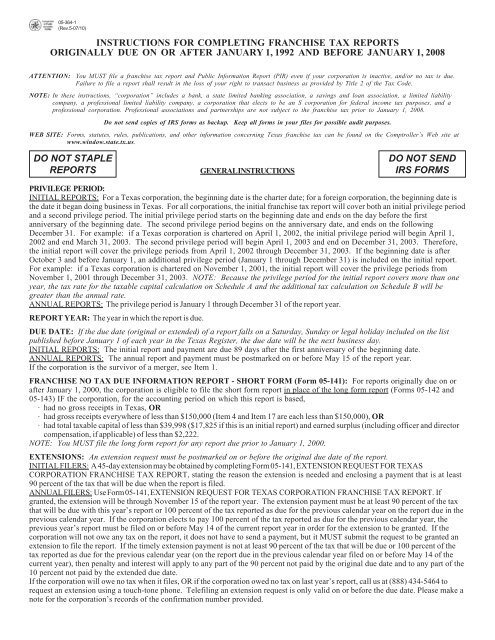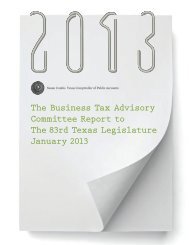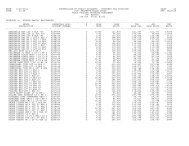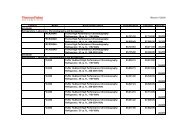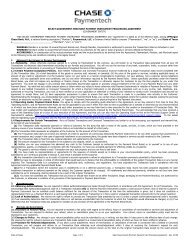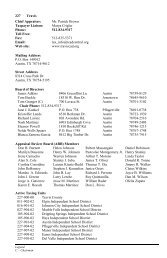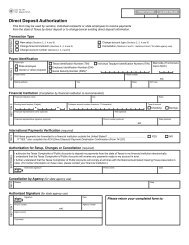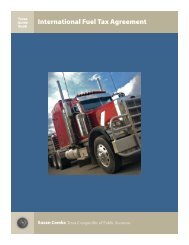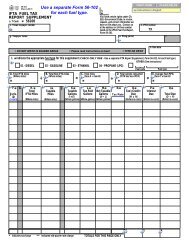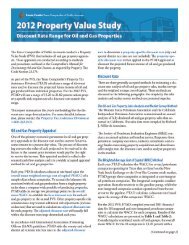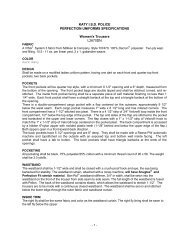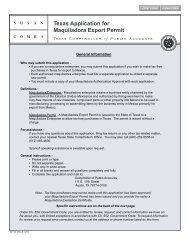Instructions for completing franchise tax reports originally due
Instructions for completing franchise tax reports originally due
Instructions for completing franchise tax reports originally due
You also want an ePaper? Increase the reach of your titles
YUMPU automatically turns print PDFs into web optimized ePapers that Google loves.
05-364-1(Rev.5-07/10)INSTRUCTIONS FOR COMPLETING FRANCHISE TAX REPORTSORIGINALLY DUE ON OR AFTER JANUARY 1, 1992 AND BEFORE JANUARY 1, 2008ATTENTION: You MUST file a <strong>franchise</strong> <strong>tax</strong> report and Public In<strong>for</strong>mation Report (PIR) even if your corporation is inactive, and/or no <strong>tax</strong> is <strong>due</strong>.Failure to file a report shall result in the loss of your right to transact business as provided by Title 2 of the Tax Code.NOTE: In these instructions, “corporation” includes a bank, a state limited banking association, a savings and loan association, a limited liabilitycompany, a professional limited liability company, a corporation that elects to be an S corporation <strong>for</strong> federal income <strong>tax</strong> purposes, and aprofessional corporation. Professional associations and partnerships are not subject to the <strong>franchise</strong> <strong>tax</strong> prior to January 1, 2008.Do not send copies of IRS <strong>for</strong>ms as backup. Keep all <strong>for</strong>ms in your files <strong>for</strong> possible audit purposes.WEB SITE: Forms, statutes, rules, publications, and other in<strong>for</strong>mation concerning Texas <strong>franchise</strong> <strong>tax</strong> can be found on the Comptroller’s Web site atwww.window.state.tx.us.DO NOT STAPLEREPORTSGENERAL INSTRUCTIONSDO NOT SENDIRS FORMSPRIVILEGE PERIOD:INITIAL REPORTS: For a Texas corporation, the beginning date is the charter date; <strong>for</strong> a <strong>for</strong>eign corporation, the beginning date isthe date it began doing business in Texas. For all corporations, the initial <strong>franchise</strong> <strong>tax</strong> report will cover both an initial privilege periodand a second privilege period. The initial privilege period starts on the beginning date and ends on the day be<strong>for</strong>e the firstanniversary of the beginning date. The second privilege period begins on the anniversary date, and ends on the followingDecember 31. For example: if a Texas corporation is chartered on April 1, 2002, the initial privilege period will begin April 1,2002 and end March 31, 2003. The second privilege period will begin April 1, 2003 and end on December 31, 2003. There<strong>for</strong>e,the initial report will cover the privilege periods from April 1, 2002 through December 31, 2003. If the beginning date is afterOctober 3 and be<strong>for</strong>e January 1, an additional privilege period (January 1 through December 31) is included on the initial report.For example: if a Texas corporation is chartered on November 1, 2001, the initial report will cover the privilege periods fromNovember 1, 2001 through December 31, 2003. NOTE: Because the privilege period <strong>for</strong> the initial report covers more than oneyear, the <strong>tax</strong> rate <strong>for</strong> the <strong>tax</strong>able capital calculation on Schedule A and the additional <strong>tax</strong> calculation on Schedule B will begreater than the annual rate.ANNUAL REPORTS: The privilege period is January 1 through December 31 of the report year.REPORT YEAR: The year in which the report is <strong>due</strong>.DUE DATE: If the <strong>due</strong> date (original or extended) of a report falls on a Saturday, Sunday or legal holiday included on the listpublished be<strong>for</strong>e January 1 of each year in the Texas Register, the <strong>due</strong> date will be the next business day.INITIAL REPORTS: The initial report and payment are <strong>due</strong> 89 days after the first anniversary of the beginning date.ANNUAL REPORTS: The annual report and payment must be postmarked on or be<strong>for</strong>e May 15 of the report year.If the corporation is the survivor of a merger, see Item 1.FRANCHISE NO TAX DUE INFORMATION REPORT - SHORT FORM (Form 05-141): For <strong>reports</strong> <strong>originally</strong> <strong>due</strong> on orafter January 1, 2000, the corporation is eligible to file the short <strong>for</strong>m report in place of the long <strong>for</strong>m report (Forms 05-142 and05-143) IF the corporation, <strong>for</strong> the accounting period on which this report is based,· had no gross receipts in Texas, OR· had gross receipts everywhere of less than $150,000 (Item 4 and Item 17 are each less than $150,000), OR· had total <strong>tax</strong>able capital of less than $39,998 ($17,825 if this is an initial report) and earned surplus (including officer and directorcompensation, if applicable) of less than $2,222.NOTE: You MUST file the long <strong>for</strong>m report <strong>for</strong> any report <strong>due</strong> prior to January 1, 2000.EXTENSIONS: An extension request must be postmarked on or be<strong>for</strong>e the original <strong>due</strong> date of the report.INITIAL FILERS: A 45-day extension may be obtained by <strong>completing</strong> Form 05-141, EXTENSION REQUEST FOR TEXASCORPORATION FRANCHISE TAX REPORT, stating the reason the extension is needed and enclosing a payment that is at least90 percent of the <strong>tax</strong> that will be <strong>due</strong> when the report is filed.ANNUAL FILERS: Use Form 05-141, EXTENSION REQUEST FOR TEXAS CORPORATION FRANCHISE TAX REPORT. Ifgranted, the extension will be through November 15 of the report year. The extension payment must be at least 90 percent of the <strong>tax</strong>that will be <strong>due</strong> with this year’s report or 100 percent of the <strong>tax</strong> reported as <strong>due</strong> <strong>for</strong> the previous calendar year on the report <strong>due</strong> in theprevious calendar year. If the corporation elects to pay 100 percent of the <strong>tax</strong> reported as <strong>due</strong> <strong>for</strong> the previous calendar year, theprevious year’s report must be filed on or be<strong>for</strong>e May 14 of the current report year in order <strong>for</strong> the extension to be granted. If thecorporation will not owe any <strong>tax</strong> on the report, it does not have to send a payment, but it MUST submit the request to be granted anextension to file the report. If the timely extension payment is not at least 90 percent of the <strong>tax</strong> that will be <strong>due</strong> or 100 percent of the<strong>tax</strong> reported as <strong>due</strong> <strong>for</strong> the previous calendar year (on the report <strong>due</strong> in the previous calendar year filed on or be<strong>for</strong>e May 14 of thecurrent year), then penalty and interest will apply to any part of the 90 percent not paid by the original <strong>due</strong> date and to any part of the10 percent not paid by the extended <strong>due</strong> date.If the corporation will owe no <strong>tax</strong> when it files, OR if the corporation owed no <strong>tax</strong> on last year’s report, call us at (888) 434-5464 torequest an extension using a touch-tone phone. Telefiling an extension request is only valid on or be<strong>for</strong>e the <strong>due</strong> date. Please make anote <strong>for</strong> the corporation’s records of the confirmation number provided.
Form 05-364-2 (Rev.5-07/10)ELECTRONIC FUNDS TRANSFER: The conditions <strong>for</strong> requiring a corporation to pay via electronic funds transfer (EFT) areoutlined in General Rule 3.9 concerning electronic filing and electronic funds transfers. In order to extend the <strong>due</strong> date of the reportfrom May 15 to August 15, a corporation that is required to pay by EFT must do the following on or be<strong>for</strong>e May 15:1) file a request <strong>for</strong> an extension (Form 05-141 or Form 05-110 or WebFile online athttps://ecpa.cpa.state.tx.us/fran_ext/index.html), and2) pay at least 90 percent of the amount of <strong>tax</strong> that will be <strong>due</strong> with this year’s report or 100 percent of the <strong>tax</strong> reported as <strong>due</strong> <strong>for</strong> theprevious calendar year on the report <strong>due</strong> in the previous calendar year. If the corporation elects to pay 100 percent of the <strong>tax</strong>reported as <strong>due</strong> <strong>for</strong> the previous calendar year, the previous year’s report must be filed on or be<strong>for</strong>e May 14 of the current reportyear in order <strong>for</strong> the extension to be granted.A corporation that must pay by EFT may request an additional extension to November 15 to file the report by doing the followingon or be<strong>for</strong>e August 15:1) file a second extension request (Form 05-141 or 05-110 or WebFile online at https://ecpa.cpa.state.tx.us/fran_ext/index.html), and2) pay the balance of the amount of <strong>tax</strong> that will be reported on the <strong>franchise</strong> <strong>tax</strong> report <strong>for</strong> the current year.The report must then be filed on or be<strong>for</strong>e November 15. If the total amount paid by August 15 is at least 99 percent of the <strong>tax</strong> <strong>due</strong>,any penalties <strong>for</strong> the underpayment will be waived, provided the total amount <strong>due</strong> is paid by November 15.NOTE: See Form 96-590, TEXNET Payment Instruction Booklet, <strong>for</strong> additional in<strong>for</strong>mation concerning requirements <strong>for</strong>electronic funds transfer payments.AMENDED REPORTS: If the corporation needs to amend a report, it must file both pages of the report along with a cover letterexplaining why it is amending the report. There<strong>for</strong>e, even if the amendment only causes a change to Schedule A, the corporationmust also complete and file Schedules B and C. Write “AMENDED” at the top of each page of the amended report. Write“AMENDED REFUND” at the top of each page if the amendment results in an overpayment. Write “AMENDED RAR REFUND”if the amendment is an overpayment <strong>due</strong> to a Revenue Agent Report adjustment.FINAL REPORT: If the corporation is no longer subject to the earned surplus component, Form 05-139, TEXAS FINALCORPORATION FRANCHISE TAX REPORT, must be filed with the Comptroller’s office within 60 days after the corporation becomesno longer subject to the earned surplus component. In the case of a Texas corporation or a non-Texas corporation with a certificateof authority (COA) to do business in Texas, a certificate of account status may be requested. See back of final report OR Form 05-359,REQUEST FOR CERTIFICATE OF ACCOUNT STATUS. The certificate will be issued by the Comptroller’s office and may be filed inthe Texas Secretary of State’s office along with the proper articles or application and filing fee.TERMINATION OF CORPORATE EXISTENCE: Once a business has filed <strong>for</strong>mal Articles of Incorporation or Organization with theTexas Secretary of State’s office, it is recognized by the State of Texas as a legal entity, whether or not it conducts business or simplyexists as an inactive shell. As such, the corporation must file <strong>tax</strong> <strong>reports</strong> until it <strong>for</strong>mally terminates its legal existence in Texasthrough the Secretary of State’s office. Texas corporations must satisfy all <strong>tax</strong> requirements be<strong>for</strong>e filing Articles of Dissolution.All documents required by the Texas Secretary of State to terminate legal existence in Texas must be received in that office be<strong>for</strong>e5:00 p.m. on December 31 to avoid liability <strong>for</strong> the next annual <strong>franchise</strong> <strong>tax</strong> period. If December 31 falls on a weekend, thedocuments must be received by 5:00 p.m. on the last working day of the year. Postmark dates will not be accepted.Foreign corporations that have been doing business in Texas, with or without a Certificate of Authority (COA), must satisfy all<strong>franchise</strong> <strong>tax</strong> requirements. In order to close the <strong>franchise</strong> <strong>tax</strong> account, the corporation must notify the Comptroller’s office inwriting, provide the date the corporation ceased doing business in Texas, file all <strong>reports</strong> <strong>due</strong> and pay any amount <strong>due</strong>.More in<strong>for</strong>mation about changing your corporate status is available online at window.state.tx.us/<strong>tax</strong>info/<strong>tax</strong>pubs.html#<strong>franchise</strong>.NOTE: This section does not apply to financial institutions.CONSOLIDATED REPORTING: Corporations are required to file based on their own financial condition. Consolidated reporting isnot allowed.SPECIFIC INSTRUCTIONS FOR SCHEDULE AACCOUNTING METHODS:GAAP Method: Unless the FIT method is allowed and elected, acorporation should report gross receipts and surplus inaccordance with Generally Accepted Accounting Principles(GAAP). The law contains some exceptions to the GAAPreporting requirements.FIT Method: The following corporations may determine theirgross receipts and surplus using the same accounting methodsused in <strong>completing</strong> the corporation’s most recent federal income<strong>tax</strong> (FIT) return (unless otherwise required by the law):1) A corporation with <strong>tax</strong>able capital of less than $1 million. Indetermining if <strong>tax</strong>able capital is less than $1 million, thecorporation shall apply the accounting methods used incomputing the federal income <strong>tax</strong> return unless anothermethod is required under the law,2) A close corporation that has 35 or fewer shareholders, or3) An S corporation.A corporation using the FIT method is not eligible to take thetemporary credit in Item 30.NOTE: Close and S corporations with <strong>tax</strong>able capital of $1million or more must notify the Comptroller of their intent touse the FIT method by marking the appropriate boxes on the<strong>franchise</strong> <strong>tax</strong> report (Item i). The notification must be made onor be<strong>for</strong>e the <strong>due</strong> date of each report in which they intend touse the FIT method.ITEM i – Box 1 Blacken this box if the corporation is usingGAAP methods <strong>for</strong> filing Schedule A of this <strong>franchise</strong> <strong>tax</strong>report.Box 2 Blacken this box if the corporation is electing to use thesame methods used in determining its FIT liability on ScheduleA of this <strong>franchise</strong> <strong>tax</strong> report. This method may only be used byqualifying corporations, as described above.
Form 05-364-3 (Rev.5-07/10)Box 3 Blacken this box if the corporation is a close corporationthat has 35 or fewer shareholders.Box 4 Blacken this box if the corporation is an S corporation.ITEM 1 - INITIAL REPORTS: If the corporation is the survivorof a merger which occurred between the date entered in Item 2(see instructions) and January 1 of the year in which this reportis <strong>due</strong>, the corporation owes <strong>tax</strong> on net <strong>tax</strong>able capital based onits financial condition as of the day after the date of the merger.The corporation should check “YES” in Item 1 and enter the dayafter the date of merger in Item 2. The new <strong>due</strong> date is 91 daysafter the date of the merger, if that date is after the original <strong>due</strong>date.ANNUAL REPORTS: If the corporation is the survivor of amerger which occurred between the end of its last accountingperiod in the year prior to this report year and January 1 of thisreport year, the corporation owes <strong>tax</strong> on net <strong>tax</strong>able capitalbased on its financial condition as of the day after the date ofmerger. The corporation should check “YES” in Item 1 andenter the day after the date of merger in Item 2.ITEM 2 - INITIAL REPORTS: Enter the last accountingperiod ending date that is at least six months after thebeginning date and at least 60 days be<strong>for</strong>e the original <strong>due</strong> dateof the initial report.Example 1: The corporation’s last normal accounting periodending date is 12-31-02. The corporation’s beginning date inTexas is 04-03-02. The original <strong>due</strong> date of its initial report is07-01-03. Six months from the corporation’s beginning datewould be 10-03-02. Sixty days be<strong>for</strong>e the corporation’s original<strong>due</strong> date would be 05-02-03. The normal accounting periodending date of 12-31-02 falls between the period of 10-03-02and 05-02-03. There<strong>for</strong>e, the corporation must use its lastnormal accounting period ending date of 12-31-02.If the corporation’s normal accounting period ending date doesnot fall between six months after the beginning date and atleast 60 days prior to the original <strong>due</strong> date, then enter the endof the month that is closest to the first anniversary of thebeginning date.Example 2: The corporation’s last normal accounting periodending date is 09-30-02. The corporation’s beginning date inTexas is 04-03-02. The original <strong>due</strong> date of its initial report is07-01-03. 09-30-02 does not fall between six months after thebeginning date and 60 days prior to the <strong>due</strong> date. There<strong>for</strong>e, thecorporation must use accounting in<strong>for</strong>mation as of 03-31-03.ANNUAL REPORTS: Enter the date of the corporation’s lastaccounting period ending in the calendar year prior to thereport year.Example 3: Report year 2003; corporation’s last accountingperiod ending date - January 31. Corporation should use01-31-02 to file the 2003 report.ITEM 3 - A corporation with zero Texas receipts on ScheduleA will have a zero apportionment factor <strong>for</strong> <strong>tax</strong>able capital andwill owe no <strong>tax</strong> on Schedule A. The survivor of a mergershould combine its receipts and the receipts of the nonsurvivors<strong>for</strong> the same accounting period used by the survivor.Gross receipts <strong>for</strong> <strong>tax</strong>able capital means all revenues that wouldbe recognized annually under a GAAP method of accounting,without deduction <strong>for</strong> the cost of property sold, or other costsincurred, unless otherwise provided <strong>for</strong> by law. Initial filersshould use gross receipts from the first date of doing businessthrough the month ending date used on line 2. Annual filersshould use 12 months of gross receipts based on the lastaccounting year-end date.Gross receipts in Texas include:· sales of real property located in Texas, including royaltiesfrom oil, gas, or other mineral interests;· sales of tangible personal property when the property isdelivered or shipped to a purchaser within Texas;· sales of tangible personal property when the property isshipped from Texas to a state in which the corporation isnot subject to <strong>tax</strong>ation (the “throwback rule”);· services per<strong>for</strong>med within Texas;· rentals of property situated in Texas;· royalties from use of patents or copyrights within Texas;· revenues from the use of trademarks, <strong>franchise</strong>s, or licenseswithin Texas, effective <strong>for</strong> <strong>reports</strong> <strong>originally</strong> <strong>due</strong> on or afterJanuary 1, 1998. For <strong>reports</strong> that are <strong>originally</strong> <strong>due</strong> prior toJanuary 1, 1998, these revenues are apportioned to thelocation of payor. These revenues do not include receiptsfrom the sale or license of computer software or programs,which are apportioned to the legal domicile of the payor;· the net gain from the sales of investments or capital assets(See definition in Item 4). A net loss is treated as zeroreceipts. If the combination of net gains and losses resultsin a net gain and both Texas and non-Texas sales haveoccurred, a separate calculation of net gains and losses onTexas sales must be made. Sales of intangibles held ascapital assets or investments (e.g., stocks, bonds, goodwill,patents, trademarks, partnership interests, etc.) tocorporations incorporated in Texas are gross receipts inTexas. If the Texas net gain is greater than the total netgain, the Texas net gain to report equals the total net gain;and· all other business receipts within Texas includingdividends as of the date declared and interest from Texaspayors. For example, dividends received from acorporation incorporated in Texas are Texas receipts.BANKING CORPORATIONS & SAVINGS AND LOANASSOCIATIONS - For <strong>reports</strong> <strong>originally</strong> <strong>due</strong> be<strong>for</strong>e January 1,2000, dividends and interest received by a banking corporationor savings and loan association are Texas receipts if thebanking corporation or savings and loan association has itscommercial domicile in Texas. For <strong>reports</strong> <strong>originally</strong> <strong>due</strong> on orafter January 1, 2000, dividends and interest received by abanking corporation or savings and loan association are Texasreceipts if they are paid by a corporation incorporated in Texasor, if they are paid by an entity or person legally domiciled inTexas. For <strong>reports</strong> <strong>originally</strong> <strong>due</strong> on or after January 1, 2002, abanking corporation should exclude from its Texas receiptsinterest earned on federal funds and interest earned onsecurities sold under an agreement to repurchase that are heldin a correspondent bank domiciled in Texas.ITEM 4 - Gross receipts everywhere include:· all sales of tangible personal property;· all rentals;· all services;· all royalties;· all other business receipts;· all dividends as of the date declared and interest; and· the net gain from the sales of investments or capital assets.A net loss is treated as zero receipts. A capital asset is anyasset, other than an investment, which is held <strong>for</strong> use in theproduction of income, and is subject to depreciation,depletion or amortization. An investment is any non-cashasset not a capital asset and not held as inventory orproceeds from the sale of inventory.
Form 05-364-4 (Rev.5-07/10)Note: For <strong>reports</strong> <strong>originally</strong> <strong>due</strong> on or after January 1, 2000,the corporation is eligible to file the Franchise No Tax DueIn<strong>for</strong>mation Report - Short Form if the corporation had grossreceipts everywhere of less than $150,000 (Item 4 and Item 17are each less than $150,000).ITEM 5 - If Texas gross receipts are zero, enter zero. If Item 3and Item 4 are the same and greater than zero, enter 1.0000.Otherwise, divide Item 3 by Item 4 and round to 4 places pastthe decimal.ITEM 6 - Enter the stated capital. Include the par or statedvalue of all shares of stock <strong>for</strong> all classes, outstanding and inthe treasury. If there is no par or stated value, use the amountactually received <strong>for</strong> the stock. Treasury Stock (stock that hasbeen issued and reacquired by the corporation) must beincluded as part of stated capital at the par or stated value ofthe stock until those shares have been canceled.LIMITED LIABILITY COMPANIES (LLCs) - Enter theamount of the members’ contributions.NOTE: Item 6 cannot be a deficit amount.ITEM 7 - Surplus calculation: Total ASSETS minus TotalDEBTS minus STATED CAPITAL equals SURPLUS.ASSETS: When determining a corporation’s assets, the assetsmay be reduced by a reserve <strong>for</strong> bad debts and by contra-assetaccounts <strong>for</strong> depletion, depreciation or amortization, providedthese items are in con<strong>for</strong>mance with the <strong>franchise</strong> <strong>tax</strong> reportingmethod, as explained under “Accounting Methods” above.Investments in other corporations must be reported using thecost method of accounting.DEBTS: Debt is defined as legally en<strong>for</strong>ceable obligationsmeasured in a certain amount of money that must be per<strong>for</strong>medor paid within an ascertainable period of time or on demand.Liabilities that do not meet the debt criteria cannot be subtractedfrom assets. Deferred investment <strong>tax</strong> credits, deferred income<strong>tax</strong>es and contingent liabilities are not debts and cannot besubtracted from assets <strong>for</strong> <strong>franchise</strong> <strong>tax</strong> purposes.STATED CAPITAL: See Item 6.SURPLUS: Some components of <strong>tax</strong>able surplus are: retainedearnings; paid-in capital; and donated capital.If the above calculation (Assets minus Debts minus StatedCapital) is used to determine surplus, no adjustment isnecessary <strong>for</strong> the cost of treasury shares purchased since theassets have already been reduced by the amount paid <strong>for</strong> thetreasury stock. However, if surplus is determined by adding theseparate component accounts, the cost of treasury sharespurchased must be subtracted from those accounts.Corporations receiving dividends must include those dividendsin surplus as of the declaration date of the declaringcorporation. Corporations declaring dividends shall excludethose dividends from surplus as of the declaration date.Dividends must be paid within one year from the date ofdeclaration to be excluded from surplus. Corporations involvedin oil and gas exploration and production activities must report inaccordance with the successful ef<strong>for</strong>ts or full cost method ofaccounting unless they are qualified to use the FIT method asexplained under “Accounting Methods.” A surplus deficit willreduce stated capital, but not below zero. If the corporation hasa surplus deficit, the deficit must be enclosed in brackets asfollows: .LLCs - Surplus means the net assets (total assets minus totaldebts) of the company minus its members’ contributions.ITEM 9 - If Item 8 is zero, Item 9 will be zero.ITEM 10 - Each of the following deductions may be takenagainst either apportioned <strong>tax</strong>able capital or apportioned andallocated earned surplus, but not both. The deductions may notreduce apportioned <strong>tax</strong>able capital below zero and no carryoverof unused deductions is allowed.1) A corporation that has been designated as an enterpriseproject, prior to September 1, 2001, as provided by theTexas Enterprise Zone Act, may deduct 50 percent of itscapital investment in the enterprise zone in which theenterprise project is located.2) A corporation may deduct the amortized cost of a solarenergy device if the device meets the criteria in Sec.171.107(b).3) Effective May 19, 1997, a corporation designated as adefense readjustment project prior to September 1, 2001,may deduct 50 percent of its capital investment in thedefense readjustment zone in which the defensereadjustment project is located. The 1998 annual report isthe first annual report in which this deduction can be taken.4) Effective June 18, 2005, a corporation may deduct theamortized cost of equipment used in a clean coal project ifthe equipment meets the criteria in 171.108(b).NOTE: If Item 9 is zero, Item 10 will be zero.ITEM 12 – The <strong>tax</strong> rate is .00250 per year of privilege period.NOTE: The <strong>tax</strong> rate <strong>for</strong> an initial report is prorated inaccordance with the privilege period covered by that report.SPECIFIC INSTRUCTIONS FOR SCHEDULE BACCOUNTING METHODS: A corporation must use thesame accounting methods in reporting gross receipts (Texasand everywhere) as used in reporting federal <strong>tax</strong>able income.Reports Originally Due Prior to January 1, 1996 - Under the<strong>franchise</strong> <strong>tax</strong> statute, the Internal Revenue Code (IRC) in effect<strong>for</strong> the 1990 calendar year must be used in computing earnedsurplus. There<strong>for</strong>e, a corporation should modify the federal<strong>tax</strong>able income as reported on the federal income <strong>tax</strong> return toadjust <strong>for</strong> any changes to the IRC after December 31, 1990.For example, although the Revenue Reconciliation Act of 1993increased the amount of depreciable property that can beexpensed <strong>for</strong> federal income <strong>tax</strong> purposes to $17,500 (IRC Sec.179), <strong>for</strong> <strong>franchise</strong> <strong>tax</strong> purposes this deduction is limited to$10,000 as required by the 1990 IRC.Reports Originally Due On or After January 1, 1996 andBe<strong>for</strong>e January 1, 1998 - The IRC in effect <strong>for</strong> the 1994calendar year must be used in computing earned surplus exceptas indicated in the “NOTE” below.Reports Originally Due on or After January 1, 1998 - TheIRC in effect <strong>for</strong> the 1996 calendar year must be used incomputing earned surplus except as indicated in the “NOTE”below.NOTE: Because the <strong>franchise</strong> <strong>tax</strong> law applicable to <strong>reports</strong><strong>due</strong> prior to January 1, 1996 required the 1990 IRC to be usedin computing earned surplus (as indicated above), acorporation may have had differences between federal <strong>tax</strong>ableincome <strong>for</strong> federal income <strong>tax</strong> purposes and federal <strong>tax</strong>ableincome used in computing earned surplus on <strong>franchise</strong> <strong>tax</strong><strong>reports</strong> <strong>due</strong> prior to 1996. If a corporation had suchdifferences, it should continue to report the differences basedon the 1990 IRC when computing earned surplus on <strong>reports</strong><strong>due</strong> after January 1, 1996.Example: If a corporation claimed a $17,500 Sec. 179deduction in reporting its federal income <strong>tax</strong> (in accordancewith 1993 IRC amendments), but was limited to a $10,000deduction in computing earned surplus on <strong>franchise</strong> <strong>tax</strong> <strong>reports</strong>
Form 05-364-5 (Rev.5-07/10)<strong>due</strong> prior to 1996 (in accordance with the 1990 IRC), thecorporation should compute depreciation on the asset based onthe $10,000 Sec. 179 deduction in computing earned surplus on<strong>reports</strong> <strong>due</strong> after January 1, 1996. This treatment allows thecorporation to maintain its basis in depreciating the affectedassets <strong>for</strong> earned surplus computations. It will result in agreater depreciation deduction in computing earned surplusthan what is reported on the federal income <strong>tax</strong> return.ITEM 13 – “BEGINNING DATE” - For INITIAL REPORTS,enter the date a Texas corporation obtained its charter or thedate a non-Texas corporation began doing business in Texas.For ANNUAL REPORTS, enter the day after the ending dateon the previous report. For example, if the 2002 annual<strong>franchise</strong> <strong>tax</strong> report was based on 12-31-01in<strong>for</strong>mation, thenthe beginning date on the 2003 annual report should be01-01-02.“ENDING DATE” - For INITIAL REPORTS, enter the lastaccounting period ending date <strong>for</strong> federal income <strong>tax</strong> purposesthat is at least 60 days be<strong>for</strong>e the original <strong>due</strong> date of the initialreport.Example 1: The corporation’s last normal accounting periodending date is 12-31-02. The corporation’s beginning date inTexas is 04-03-02. The original <strong>due</strong> date of the initial report is07-01-03. Sixty days be<strong>for</strong>e the original <strong>due</strong> date would be05-02-03. The corporation’s normal accounting period endingdate of 12-31-02 occurs at least 60 days be<strong>for</strong>e 07-01-03.There<strong>for</strong>e, the corporation must use 12-31-02 as its endingdate.Example 2: The corporation’s normal accounting periodending date is 06-30. The corporation’s beginning date inTexas is 04-03-02. The original <strong>due</strong> date of the initial report is07-01-03. Sixty days be<strong>for</strong>e the original <strong>due</strong> date is 05-02-03.The corporation’s normal accounting period ending date of 06-30-03 does not occur at least sixty days prior to the original <strong>due</strong>date of 07-01-03. There<strong>for</strong>e, the corporation must use 06-30-02as the ending date.For ANNUAL REPORTS, enter the last accounting periodending date <strong>for</strong> federal income <strong>tax</strong> purposes in the year be<strong>for</strong>ethe year the report is <strong>originally</strong> <strong>due</strong>.ITEM 14 - Public Law 86-272 applies if the only businessactivity of the corporation within this state is the solicitation o<strong>for</strong>ders <strong>for</strong> sales of tangible personal property. If orders are sentoutside the state <strong>for</strong> approval or rejection and, if approved, arefilled by shipment or delivery from a point outside this state, PL86-272 applies, and the corporation is not subject to the earnedsurplus component. Enter the date the corporation becameprotected by PL 86-272. If this protected date is be<strong>for</strong>e thecalendar year in which this report is <strong>due</strong>, skip to Item 28, enterzero, and complete the remainder of the report. If the protecteddate is within the calendar year in which this report is <strong>due</strong>, thecorporation is subject to the earned surplus component <strong>for</strong> thisreporting period and the remainder of the report must becompleted. Corporations chartered in Texas are not protectedby PL 86-272 and ARE subject to the earned surpluscomponent.ITEM 15 – Enter the amount of business losses from previous<strong>franchise</strong> <strong>tax</strong> <strong>reports</strong> that is available to be used to offsetapportioned earned surplus and allocated earned surplus. Abusiness loss is a negative earned surplus amount afterapportionment and allocation. Amounts in Item 15 should notbe in brackets. The business loss shall be carried <strong>for</strong>ward fiveyears or until the loss is exhausted, whichever occurs first. Acorporation may not convey, assign, or transfer a business lossto another entity.Example: If a corporation had no losses on any <strong>franchise</strong> <strong>tax</strong><strong>reports</strong> be<strong>for</strong>e the 2000 report, but had a $10,000 loss in Item 25of the 2000 report and a $5,000 loss in Item 25 of the 2001 report,the $15,000 should be entered in Item 15 of the 2002 <strong>franchise</strong> <strong>tax</strong>report as the business loss carryover.A business loss from a <strong>tax</strong> year that ends be<strong>for</strong>e January 1,1991 may not be used to reduce net <strong>tax</strong>able earned surplus;there<strong>for</strong>e, this item should be zero <strong>for</strong> the 1992 <strong>franchise</strong> <strong>tax</strong>report. Allocated earned surplus does not apply to <strong>reports</strong> <strong>due</strong>be<strong>for</strong>e January 1, 1994. No business loss amount from prioryears can be entered in Item 15 when filing an initial <strong>franchise</strong><strong>tax</strong> report.NOTE: For <strong>reports</strong> <strong>due</strong> on or after January 1, 1994, see Item24 be<strong>for</strong>e <strong>completing</strong> Items 16, 17 and 19. Do not includeallocated earned surplus amounts in Items 16, 17 and 19.ITEM 16 - Texas gross receipts and gross receipts everywhereshould be reported <strong>for</strong> the period entered in Item 13. Grossreceipts <strong>for</strong> <strong>tax</strong>able earned surplus means all revenuesreportable by a corporation on its federal <strong>tax</strong> return, withoutdeduction <strong>for</strong> the cost of property sold, or other costs incurred,unless otherwise provided <strong>for</strong> by law.Gross receipts in Texas include:· sales of real property located in Texas, including royaltiesfrom oil, gas, or other mineral interests;· sales of tangible personal property when the property isdelivered or shipped to a purchaser within Texas;· sales of tangible personal property when the property isshipped from Texas to a state in which the corporation isnot subject to any <strong>tax</strong> on, or measured by, net incomewithout regard to whether the <strong>tax</strong> is imposed (the“throwback rule”);· services per<strong>for</strong>med within Texas;· rentals of property situated in Texas;· royalties from use of patents or copyrights within Texas;· revenues from the use of trademarks, <strong>franchise</strong>s, or licenseswithin Texas, effective <strong>for</strong> <strong>reports</strong> <strong>originally</strong> <strong>due</strong> on or afterJanuary 1, 1998. For <strong>reports</strong> that are <strong>originally</strong> <strong>due</strong> priorto January 1, 1998, these revenues are apportioned to thelocation of payor. These revenues do not include receiptsfrom the sale or license of computer software or programs,which are apportioned to the legal domicile of the payor;· the net gain from the sales of investments or capital assets(See definition in Item 17.) A net loss is treated as zeroreceipts. If the combination of net gains and losses resultsin a net gain and both Texas and non-Texas sales haveoccurred, a separate calculation of net gains and losses onTexas sales must be made. Sales of intangibles held ascapital assets or investments (e.g., stocks, bonds, goodwill,patents, trademarks, partnership interests, etc.) tocorporations incorporated in Texas are gross receipts inTexas. If the Texas net gain is greater than the total netgain, the Texas net gain to report equals the total net gain;and· all other business receipts within Texas. For example,interest received from a corporation incorporated in Texasis a Texas receipt.BANKING CORPORATIONS & SAVINGS AND LOANASSOCIATIONS - For <strong>reports</strong> <strong>originally</strong> <strong>due</strong> be<strong>for</strong>e January 1,2000, dividends and interest received by a banking corporationor savings and loan association are Texas receipts if thebanking corporation or savings and loan association has itscommercial domicile in Texas. For <strong>reports</strong> <strong>originally</strong> <strong>due</strong> on orafter January 1, 2000, dividends and interest received by a
Form 05-364-6 (Rev.5-07/10)banking corporation or savings and loan association are Texasreceipts if they are paid by a corporation incorporated in Texasor, if they are paid by an entity or person legally domiciled inTexas. For <strong>reports</strong> <strong>originally</strong> <strong>due</strong> on or after January 1, 2002, abanking corporation should exclude from its Texas receiptsinterest earned on federal funds and interest earned onsecurities sold under an agreement to repurchase that are heldin a correspondent bank domiciled in Texas.Any item of revenue that is excluded from net <strong>tax</strong>able earnedsurplus under Texas law or United States law is not included inTexas gross receipts or gross receipts everywhere. Forexample, a corporation should not include in Texas grossreceipts:· income recorded because of IRC Sections 78 or 951-964;· dividends received from a subsidiary, associate, oraffiliated corporation that does not transact a substantialportion of its business or regularly maintain a substantialportion of its assets in the United States;· dividends and/or interest received from federal obligationsexcluded from the earned surplus <strong>tax</strong> base; or· dividends <strong>for</strong> which a “dividends received” deduction isallowed on Schedule C of Form 1120 (also reported in Item20a of this <strong>franchise</strong> <strong>tax</strong> report.)NOTE: For <strong>reports</strong> <strong>due</strong> on or after January 1, 1994, do notinclude allocated earned surplus amounts in Item 16. SeeItem 24.ITEM 17 - Gross receipts everywhere include:· all sales of tangible personal property;· all rentals;· all services;· all royalties;· all other business receipts;· all dividends and interest not otherwise excluded byoperation of law or rules; and· the net gain from the sales of investments or capital assets.A net loss is treated as zero receipts. A capital asset is anyasset, other than an investment, which is held <strong>for</strong> use in theproduction of income, and is subject to depreciation,depletion, or amortization. An investment is any non-cashasset not a capital asset and not held as inventory orproceeds from the sale of inventory.Any item of revenue that is excluded from net <strong>tax</strong>able earnedsurplus under Texas law or United States law is not included ingross receipts. For example, a corporation should not includein gross receipts:· income recorded because of IRC Sections 78 or 951-964;· dividends received from a subsidiary, associate, oraffiliated corporation that does not transact a substantialportion of its business or regularly maintain a substantialportion of its assets in the United States;· dividends and/or interest received from federal obligationsexcluded from the earned surplus <strong>tax</strong> base; or· dividends <strong>for</strong> which a “dividends received” deduction isallowed on Schedule C of Form 1120 (also reported in Item20a of this <strong>franchise</strong> <strong>tax</strong> report.)NOTE: For <strong>reports</strong> <strong>due</strong> on or after January 1, 1994, do notinclude allocated earned surplus amounts in Item 17. SeeItem 24.ITEM 18 - If Texas gross receipts are zero, enter zero. If Item 16and Item 17 are the same and greater than zero, enter 1.0000.Otherwise, divide Item 16 by Item 17 and round to 4 places pastthe decimal.ITEM 19 - Except <strong>for</strong> the adjustments indicated below,1) corporations and LLCs filing a Form 1120 <strong>for</strong> federal income<strong>tax</strong> purposes should enter the federal <strong>tax</strong>able income be<strong>for</strong>enet operating loss deductions and special deductions;2) LLCs that are treated as partnerships <strong>for</strong> federal income <strong>tax</strong>purposes and S corporations should enter the amount ofincome reportable to the Internal Revenue Service as<strong>tax</strong>able to the members or shareholders (which includesordinary income and certain income and expense itemsreflected on Schedule K of Form 1065 or Form 1120S);3) LLCs that are treated as sole proprietorships <strong>for</strong> federalincome <strong>tax</strong> purposes should report the <strong>tax</strong>able income anddeductions reflected on Form 1040, including amountslisted on attachments and schedules that relate to the LLC.An LLC treated as a division of a corporation <strong>for</strong> federalincome <strong>tax</strong> purposes is subject to <strong>franchise</strong> <strong>tax</strong> as a separatelegal entity. A consolidated <strong>franchise</strong> <strong>tax</strong> report with thecorporation cannot be filed.A qualified Subchapter S subsidiary is subject to <strong>franchise</strong> <strong>tax</strong>as a separate legal entity. A consolidated <strong>franchise</strong> <strong>tax</strong> reportwith its parent cannot be filed.Be<strong>for</strong>e entering these federal <strong>tax</strong>able income amounts on Line19, the following adjustments must be made:· If the income includes dividends and/or interest on federalobligations, these amounts should be subtracted.· Any amounts that must be included in allocated earnedsurplus on Line 24 must be subtracted.· For <strong>reports</strong> <strong>due</strong> after September 11, 2001, no deduction isallowed <strong>for</strong> any “bonus depreciation” created as a result ofthe Job Creation and Workers Assistance Act of 2002.There<strong>for</strong>e, any bonus depreciation taken on the federalincome <strong>tax</strong> return must be added back in the computationof earned surplus. Also, see the discussion under“Accounting Methods” <strong>for</strong> Schedule B.Reports Originally Due Prior to January 1, 1996 - TheInternal Revenue Code (IRC) in effect <strong>for</strong> the 1990 calendaryear must be used in computing earned surplus. See thediscussion under “Accounting Methods” <strong>for</strong> Schedule B.Reports Originally Due On or After January 1, 1996 - If therequired use of the 1990 IRC in computing earned surplus on<strong>reports</strong> <strong>originally</strong> <strong>due</strong> prior to 1996 (as discussed above) causeddifferences between federal <strong>tax</strong>able income <strong>for</strong> federal income<strong>tax</strong> purposes and federal <strong>tax</strong>able income used in computingearned surplus, the corporation should report the differenceswhen computing earned surplus based on the 1990 IRC. Seethe discussion under “Accounting Methods” <strong>for</strong> Schedule B <strong>for</strong>additional in<strong>for</strong>mation about the IRC that must be used incomputing earned surplus. If the amount is negative, bracketthe amount as follows: .ITEM 20a. Enter total deductions allowed on Schedule C, U. S.Corporation Income Tax Return Form 1120.b. Enter amount of income included in Item 19 that is incomebecause of IRC Sections 78 or 951-964. Enter amount ofdividends included in Item 19 that was received from asubsidiary, associate, or affiliated corporation that does nottransact a substantial portion of its business or regularlymaintain a substantial portion of its assets in the United States.ITEM 21 - Skip this item and go to Item 22 if the corporation,bank, or LLC is not a subsidiary and:
Form 05-364-7 (Rev.5-07/10)1) has 35 or fewer shareholders/members <strong>for</strong> the entire periodin Item 13, or2) is an S corporation <strong>for</strong> the entire period.Also skip this item if the corporation, bank, or LLC is asubsidiary and the parent qualifies <strong>for</strong> the exception asdescribed above.If the corporation does not qualify <strong>for</strong> one of the exceptionsabove:· Corporations (other than banking corporations) shouldenter the amount of compensation reportable to officers anddirectors on Forms W-2 and 1099 <strong>for</strong> the portion of theperiod in Item 13 during which the corporation does notqualify <strong>for</strong> an exception. LLCs that are treated ascorporations <strong>for</strong> federal income <strong>tax</strong> purposes should enterthe amount of compensation reportable to managers andofficers on Forms W-2 and 1099 <strong>for</strong> the portion of theperiod in Item 13 during which the LLC does not qualify<strong>for</strong> an exception.· Banks should enter compensation of executive officers anddirectors reportable on Forms W-2 and 1099 <strong>for</strong> the portionof the period in Item 13 during which the bank does notqualify <strong>for</strong> an exception.· LLCs treated as partnerships <strong>for</strong> federal income <strong>tax</strong>purposes should enter guaranteed payments orcompensation to managers and officers <strong>for</strong> services <strong>for</strong> theportion of the period in Item 13 during which the LLCdoes not qualify <strong>for</strong> an exception.NOTE: Any person designated as an officer is presumed to bean officer if the person (1) holds an office created by the boardof directors or by the corporate charter or by-laws, and (2) haslegal authority to bind the corporation with third parties. SeeRule 3.558 <strong>for</strong> more in<strong>for</strong>mation.ITEM 22 - If this amount is negative, bracket the amount asfollows: . If Item 19 is negative, Item 20 will increasethe negative amount and Item 21 will reduce the negativeamount.ITEM 23 - If Item 22 is negative, the percentage of thenegative amount apportioned to Texas should be entered inItem 23 in brackets as follows: .ITEM 24 - Skip this item if filing a report <strong>due</strong> on or afterJanuary 1, 1992 and be<strong>for</strong>e January 1, 1994. If thecorporation’s commercial domicile is not in Texas, Item 24should be zero. Corporations with a Texas commercialdomicile may need to allocate certain income items to Texas.Income items that are considered non-unitary, except dividendsand interest, must be allocated to Texas and reported in Item24. Non-unitary income must be entered in Item 24 net ofrelated expenses. This amount must be excluded from Items16, 17, and 19. If the amount is negative, bracket the amountas follows: .NOTE: All income is presumed to be unitary. If all of acorporation’s income is used in its operations, it will beconsidered unitary income. For example, investment incomefrom stocks, bonds, etc. that is part of operating revenue isconsidered unitary. Such income will be apportioned and willnot be subject to allocation.ITEM 26 - Each of the following deductions may be takenagainst either apportioned <strong>tax</strong>able capital or apportioned andallocated earned surplus, but not both. The deductions may notreduce apportioned and allocated earned suplus below zero andno carryover of unused deductions is allowed.1) A corporation that has been designated as an enterpriseproject prior to September 1, 2001, as provided by theTexas Enterprise Zone Act, may deduct 5 percent of itscapital investment in the enterprise zone in which theenterprise project is located. The deduction may not reduceapportioned and allocated earned surplus below zero and nocarryover of unused deductions is allowed.2) A corporation may deduct 10 percent of the amortized costof a solar energy device if the device meets the criteria inSec. 171.107(b).3) Effective May 19, 1997, a corporation designated as adefense readjustment project prior to September 1, 2001,may deduct 5 percent of its capital investment in thedefense readjustment zone in which the defensereadjustment project is located. The 1998 annual report isthe first annual report in which this deduction can be taken.4) Effective June 18, 2005, a corporation may deduct 10 percentof the amortized cost of equipment used in a clean coalproject if the equipment meets the criteria in Sec.171.108(b).NOTE: If Item 25 is zero or less, enter zero in Item 26.ITEM 27 - Enter the amount of business losses from previous<strong>franchise</strong> <strong>tax</strong> <strong>reports</strong> that will be used this year to reduceapportioned and allocated earned surplus. A business loss is anegative earned surplus amount after apportionment andallocation. No business loss amount can be entered in Item 27when filing an initial <strong>franchise</strong> <strong>tax</strong> report. Allocated earnedsurplus does not apply to <strong>reports</strong> <strong>due</strong> be<strong>for</strong>e January 1, 1994.The following examples illustrate the application of thebusiness loss carryover <strong>for</strong> a corporation that has negativeapportioned and allocated earned surplus (Item 25) on its 2002<strong>franchise</strong> <strong>tax</strong> report of $10,000. The available business loss tobe used to offset apportioned and allocated earned surplus onthe 2003 <strong>franchise</strong> <strong>tax</strong> report is $10,000.Example 1: If the corporation’s apportioned and allocatedearned surplus less allowable deductions is $14,000 on its 2003<strong>franchise</strong> <strong>tax</strong> report, then the $10,000 loss carryover should beentered in Items 15 and 27 of the 2003 <strong>franchise</strong> <strong>tax</strong> report.Example 2: If the corporation’s apportioned and allocatedearned surplus less allowable deductions is $3,000 on its 2003<strong>franchise</strong> <strong>tax</strong> report, then the corporation should enter $10,000in Item 15 and $3,000 in Item 27 of its 2003 <strong>franchise</strong> <strong>tax</strong>report.The business loss amount in Item 27 will not necessarily be thesame amount of loss that the corporation reported on its FederalIncome Tax Return (e.g. Form 1120, 1120S, etc.). Apportionedplus allocated earned surplus, less allowable deductions, maynot be reduced below zero by a business loss carryover. If Item25 is zero or less, enter zero in Item 27. Amounts in Items 15and 27 should not be in brackets.For more in<strong>for</strong>mation about business losses and business losscarryovers, see Item 15 instructions.ITEM 28 - If Item 25 is zero or less, Item 28 will be zero.ITEM 29 - If Item 28 is zero, Item 29 will be zero.ITEM 30 - This credit is only available to corporations thatpreserved their right in writing to take the credit by March 2,1992. In order to begin taking the credit, the corporation mustnotify the Comptroller that it will take the credit on or be<strong>for</strong>e theoriginal <strong>due</strong> date of the report on which the corporation begins
Form 05-364-8 (Rev.5-07/10)to take the credit. This can be done on the extension <strong>for</strong>m or byentering the credit in Item 30 of the <strong>franchise</strong> <strong>tax</strong> report filed onor be<strong>for</strong>e the original <strong>due</strong> date of the report. Once thecorporation begins taking the credit, the credit should be enteredin Item 30 and the additional <strong>tax</strong> must be paid (see instructions<strong>for</strong> Item 33). Thus, even if the corporation owes no <strong>tax</strong> on net<strong>tax</strong>able earned surplus (Item 29 is zero), the corporation mustenter the credit amount in Item 30 and add the additional <strong>tax</strong> inItem 33. If the corporation fails to enter the appropriate amounts,the credit will be revoked <strong>for</strong> the current and future <strong>reports</strong>. Acorporation may claim the credit <strong>for</strong> not more than 20consecutive privilege periods beginning with the first report <strong>due</strong>after January 1, 1992. A corporation may make only one electionunder this section and the election may not be conveyed,assigned, or transferred to another entity.The credit is computed as follows:1) determine the amount, as of the end of the corporation’saccounting year ending in 1991, that is the excess of thebasis used <strong>for</strong> financial accounting purposes over the basisused <strong>for</strong> federal income <strong>tax</strong> purposes of qualifying assetsand liabilities that at some future date will reverse (use thisamount every year the credit is taken);2) multiply this amount by the apportionment factor enteredin Item 18 of the corporation’s 1992 <strong>franchise</strong> <strong>tax</strong> report(use this apportionment factor every year the credit istaken);3) multiply this amount by 5 percent per privilege period;4) multiply this amount by the <strong>tax</strong> rate <strong>for</strong> the earned surpluscomponent (Item 29) in effect <strong>for</strong> the year the credit istaken.NOTE: If the corporation wants to take the temporary credit,it must file the long <strong>for</strong>m report as its in<strong>for</strong>mation report.ITEM 33 - If the corporation has elected to take the temporarycredit on this or previous <strong>reports</strong>, then an additional <strong>tax</strong> <strong>due</strong>must be calculated by multiplying Item 11, Schedule A, by.002, <strong>for</strong> an annual report, or the temporary credit will berevoked <strong>for</strong> the current and future <strong>reports</strong>. The .002 rate willbe prorated on initial <strong>reports</strong>. Even if the corporation did nothave <strong>tax</strong> <strong>due</strong> on net <strong>tax</strong>able earned surplus (Item 29), theadditional <strong>tax</strong> <strong>due</strong> must be paid or the temporary credit will berevoked <strong>for</strong> the current and future <strong>reports</strong>. If Item 11, ScheduleA, is zero, then no additional <strong>tax</strong> is <strong>due</strong> and the temporarycredit may still be taken to reduce <strong>tax</strong> <strong>due</strong> on net <strong>tax</strong>able earnedsurplus.ITEM 34 - For any credits claimed under Section (3) or (4) below,Schedule D must be completed and submitted with the <strong>tax</strong> report.Credits that may be entered in Item 34 include:1) Credit amounts reported by banks <strong>for</strong> <strong>tax</strong> erroneously paidon <strong>reports</strong> <strong>originally</strong> <strong>due</strong> prior to January 1, 1992.2) Credit amounts <strong>for</strong> sales <strong>tax</strong> paid on property used inmanufacturing pursuant to Sec. 171.0021 of the Texas TaxCode. The credit is the sum of: (A) 25 percent of the state<strong>tax</strong> paid to the state under Chapter 151 <strong>for</strong> propertypurchased on or after October 1, 1991, and on or be<strong>for</strong>eDecember 31, 1992; and (B) 50 percent of the state <strong>tax</strong> paidto the state under Chapter 151 <strong>for</strong> property purchased on orafter January 1, 1993, and on or be<strong>for</strong>e September 30, 1993.The credit is not available <strong>for</strong> local <strong>tax</strong>es. The credit may beclaimed, until completely used, on any of the first five<strong>reports</strong> that are <strong>originally</strong> <strong>due</strong> on or after January 1, 1994.The credit claimed on a report may not exceed the <strong>tax</strong> <strong>due</strong>. Acorporation may not convey, assign, or transfer the credit toanother entity. NOTE: The 1998 report is the last report <strong>for</strong>which a corporation can claim this credit.3) Credits allowed to title insurance companies. See Rule3.566 <strong>for</strong> credit qualifications and calculations.4) Total <strong>tax</strong> credits from Item 14 of Schedule D, the TexasFranchise Tax Credit Summary. The total amount ofcredits entered in Item 34 cannot be used to reduce Item 35below zero.NOTE: Credits <strong>for</strong> extension payments or prior paymentsshould not be entered in this item. Enter extension payments orprior payments in Item 37.SPECIFIC INSTRUCTIONS FOR SCHEDULE CITEM 36 - If Item 35 is less than $100, the corporation owesno <strong>tax</strong>. For <strong>reports</strong> <strong>originally</strong> <strong>due</strong> on or after January 1, 2000, ifItem 4 and Item 17 are each less than $150,000, the corporationowes no <strong>tax</strong>. The corporation must file completed Schedules A,B, and C as its in<strong>for</strong>mation report <strong>for</strong> any report <strong>due</strong> prior toJanuary 1, 2000 or if the corporation wants to take thetemporary credit.ITEM 37 - Enter prior payments, such as an extensionpayment.ITEMS 39 & 40 - PENALTY AND INTEREST INEXTENSION SITUATIONS:INITIAL REPORTS - If the extension payment is not at least 90percent of the <strong>tax</strong> that is <strong>due</strong> when the initial report is filed,then penalty and interest will be assessed based on the original<strong>due</strong> date of the report.ANNUAL REPORTS - If the extension payment <strong>for</strong> the 1993through 1997 annual <strong>reports</strong> is not at least 100 percent of the<strong>tax</strong> paid in the prior year or 90 percent of the <strong>tax</strong> that will be<strong>due</strong> with the current year’s report, then penalty and interest willapply to any part of the 90 percent not paid on or be<strong>for</strong>e May15, and any part of the 10 percent not paid on or be<strong>for</strong>eNovember 15. If the extension payment <strong>for</strong> the 1998 andsubsequent <strong>reports</strong> is not at least 100 percent of the <strong>tax</strong> reportedas <strong>due</strong> <strong>for</strong> the previous calendar year (on the report <strong>due</strong> in theprevious calendar year filed on or be<strong>for</strong>e May 14 of the currentyear) or 90 percent of the <strong>tax</strong> that will be <strong>due</strong> with the currentyear’s report, then penalty and interest will apply to any part ofthe 90 percent not paid on or be<strong>for</strong>e May 15, and any part of the10 percent not paid on or be<strong>for</strong>e November 15. See Rule 3.545<strong>for</strong> more in<strong>for</strong>mation. For corporations required to pay their<strong>franchise</strong> <strong>tax</strong> by electronic funds transfer (EFT), see Rule 3.575<strong>for</strong> penalty and interest in extension situations.INTEREST CALCULATION -See www.window.state.tx.us/<strong>tax</strong>info/int_rate.html <strong>for</strong> morein<strong>for</strong>mation about computing interest.SIGNATURE: The report must be signed on the second page byan officer, director, or other authorized person of the corporation,LLC or financial institution.


